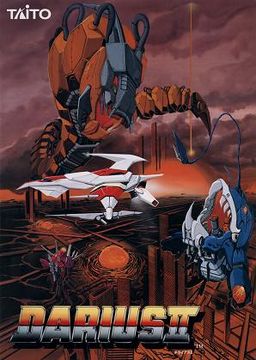- Darius II (arcade game)
-
Darius II 
Japanese arcade flyerDeveloper(s) Taito Publisher(s) Taito Platform(s) Arcade, Sega Mega Drive, Sega Master System, TurboGrafx-CD, Sega Saturn Release date(s) 1989, 1990, 1992, 1996 Genre(s) Scrolling Shooter Mode(s) Single-player or two-player simulatenous action Darius II, released outside of Japan as Sagaia[1], is a 1989 arcade video game by Taito. It is the direct sequel to Darius, first released in arcades in 1989. The arcade version kept the same three-screen format as the first game. The power-up system changed slightly: to obtain power-ups, the player had to destroy complete waves of a particular enemy.
Contents
Story
Darius II takes place sometime after the first Darius game; the colonized planet Darius is recuperating from its invasion from the alien Belser Army thanks to that game's heroes Proco and Tiat. The Darius inhabitants have since situated themselves on the planet Olga while Darius' societies, architecture and attacked areas were being repaired. The space flight Head Quarters established on Olga picks up an SOS signal coming from the Earth where the first colonists of Darius originated before colonizing Darius; the signal included the description of alien ships similar to that of the Belser Army. Suspecting that these might be their remaining Earthling ancestors, the people of Darius sends both Proco Jr. and Tiat Young to help them.
Description
This game contains the red, green and blue items, as in almost all Darius series and they do the same functions (the red powers up the shots, the green powers up the bombs and the blue regenerates and powers up the arm shield).
This game has the following 2 downsides in comparison with the rest of the Darius games: The first one is that there are not power up bars. This implies that when a Silver Hawk is destroyed, they go back to the very first level for the shots and bombs. The second one is that the shots don't pierce through the enemies, which implies that the player cannot destroy an enemy unless they first destroys the enemies in front of it.
Two new power-ups were added: a golden item containing a new weapon power-up which gives the player green, vertical lasers that do pierce through enemies, and a rainbow-colored item that powers up all the players weapons. The game is set in the inner half of the Solar system, and has the same branching level structure as Darius.[2]
Another great difference between the power ups on Darius II and the rest of the Darius series (except Super Darius II and Darius Twin) is that on Darius II, the player must destroy a complete formation of 8 certain unarmed ship types in order to get a power up.
Another new feature in Darius II is the appearance of minibosses named captains- large enemies that appear near the middle of a level, with similar abilities to the game's normal bosses (such as extravagant weapons, or the inability to be damaged without first exposing a vulnerable area). The captains in Darius II are in fact smaller versions of the bosses from Darius.[2]
Ports
Darius II was ported to the Mega Drive/Genesis in 1990 and Sega Master System in 1992, under the names "Darius II" (Japanese Mega Drive) and "Sagaia" (European Master System, US Genesis; not to be confused with the Game Boy game related to the original Darius). It has 2 main differences with respect to Darius II. The first one is that Steel Spine and Killer Hijia are not present (the player(s) only has to defeat Alloy Lantern in order to advance to the Venus Stage). The second difference is an exclusive new boss called Nehonojia (a mackerel skeleton) on the X area. In 1993, the PC Engine CD received an enhanced port titled Super Darius II, featuring all-new exclusive bosses and an arranged soundtrack. The arcade version was later ported to the Sega Saturn in 1996, complete with two-player mode and stretchable wide screen modes.
References
- ^ "Sagaia". arcade-museum.com. http://flyers.arcade-museum.com/?page=thumbs&db=videodb&id=4187. Retrieved 11 June 2011.
- ^ a b "Hardcore Gaming 101: Darius". Gamespy. http://hardcoregaming101.net/darius/darius.htm.
External links
- Darius II at the Killer List of Videogames
- Sagaia at the Killer List of Videogames
Darius video games Arcade games Console-exclusive games Related games Categories:- 1989 video games
- Arcade games
- Sega Mega Drive games
- Sega Saturn games
- Video game sequels
Wikimedia Foundation. 2010.

